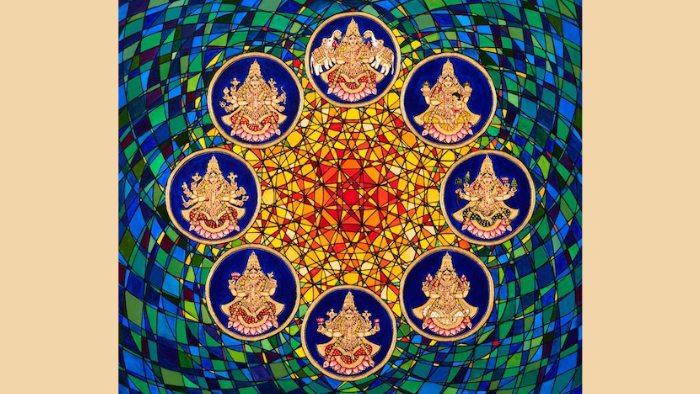Team CSP wishes you all a very happy Deepavali. We hope your homes are bright with the light from the diyas, fragrant with flowers and sweets.
Deepavali, the festival of lights, is celebrated to mark Shri Rama’s return to Ayodhya after the fourteen year exile. People across the country and the world celebrate Deepavali in various ways. In the east, Kali puja, also known as Shayma Puja is performed. It is believed that Ma Parvati took the avatara of Kali Devi to kill the demon Bakasura. People throng at Kalighat and Dakshineswar to offer prayers.
In the west, Lakshmi puja is performed with grandeur. In Maharashtra, Deepavali begins with Vasu Baras to offer their prayers to the cow. Since this is the beginning of the wedding season, Tulsi Vivah and Bhav Bij are celebrated.
In the south, Deepavali is celebrated on Naraka Chaturdashi. It marks the day when Sri Krishna and Ma Kali killed Narakasura. On this day, people have an oil bath, wear new clothes, and offer worship to Devi Lakshmi. In Karnataka, Bali Padyami is celebrated when people worship King Bali.
In the north, Deepavali begins with Dhanteras and is celebrated for five days. Dhanteras is also celebrated as Dhanvantari Jayanthi (National Ayurveda Day). Dhanteras is followed by Choti Deepavali when Devi Lakshmi and Ganesha are prayed to. Diwali is celebrated the next day followed by Govardhan puja. The last day is known as Bhai-Dooj.

Deepavali falls during the Sharad Ritu (autumn). As the world revels in the bright spirits of Deepavali, it is interesting to note that most of our practices during the festivities follow the principles of Ayurveda.
In the south, it is customary to have an oil bath. People wake up early in the morning, apply heated sesame oil on the head and to the body, and have a hot bath. They then wear new clothes, and binge on a variety of sweets like laddoos, mysore pak, pakodas, thengol, chakli and chivda. All these sweets are made with an abundance of ghee.
Now, how are these practices in line with Ayurveda. In Ayurveda, ritucharya is an important concept. Each season has its own set of rules to follow and they make sure that the individual stays healthy. Sharad ritu is a period of dry and sunny, and during this period, there is an increase in Pitta dosha.
Sesame oil reduces Vata and Kapha doshas and protects the skin from drying. Also, if sesame oil is applied before sun rise, it prevents the increase in Pitta. People also apply a paste of turmeric, besan and sandalwood, mixed with sesame oil and milk, that moisturises the skin. Oil baths in Ayurveda are important because they reduce the signs of ageing (Jara), exhaustion (Shrama) and Vata dosha.
Sweets made with ghee, cane sugar and jaggery can be fatty, but they help to balance the increased Pitta dosha. Apart from these ingredients, Deepavali snacks are also made with rice flour, jowar and bajra.

Apart from these snacks, in Tamil Nadu, a special “medicine” is made with ginger, jaggery, ghee, and other spices. This is known as Lehiyam or Deepavali Marundhu (medicine in Tamil). The blend of species include black pepper, cumin, nutmeg, coriander seeds and ajwain, and this blend aids in easy digestion of the heavy food that is taken up during the day. Also, ghee and jaggery makes sure Pitta dosha is in balance.
We must commend our ancestors for this well-thought out meal plan. They made sure that people were in the best health to continue their festivities.
Deepavali in the country is a sight to see. Every house is lit with diyas, decorated with flowers, and is fragrant with numerous sweets. Apart from the celebrations in India, Deepavali is celebrated across the world. Allow me to take you to the celebrations in South Africa, Trinidad & Tobago and Guyana.
South Africa has the largest immigrant Indian community. The celebrations that take place are very similar to those in India. People light lamps, decorate their house, distribute sweets and burst crackers.Last year, the mayor of Johannesburg along with Anju Ranjan, the Consul-General of India opened an exhibition of medicinal plants used in Ayurveda.
It is also important to note that two indigenous communities, the Zulus and the Amandebeles celebrated Deepavali last year. Professor Ishwar Ramlutchman is the head of the Sivananda World Peace Foundation and is the prince of the Zulu nation. He organised the celebrations within his region. The monarch said that Deepavali was a unifying force for people to come together and endure the struggles. He added that for everyone celebrating Deepavali, the diya was a reminder that even in the midst of darkness, light will prevail. Knowledge will win over ignorance.
In Trinidad & Tobago, families and friends come together at dusk and light lamps around their homes, in any open space. They shape bamboo stalks in unique ways to place their diyas. The communities also hold competitions for the best bamboo bending. Divali Nagar in Central Trinidad happens to be the first Hindu theme park in the world.

Deepavali is a public holiday in Trinidad & Tobago and in Guyana. In Guyana, the Hindu Dharmic Sabha organises motorcades with diyas on display. In both places, fireworks are used to celebrate the festival.
Indian diaspora celebrates Deepavali in unique ways across the world, making them almost feel like they are home. Indian student communities in universities abroad come together to celebrate Deepavali as a family. Indian communities in different parts of the world have their own beautiful traditions, bringing everyone together to make Deepavali enjoyable.
We hope to see these traditions continue for decades to come and Team CSP once again wishes everyone a very happy and safe Deepavali!




